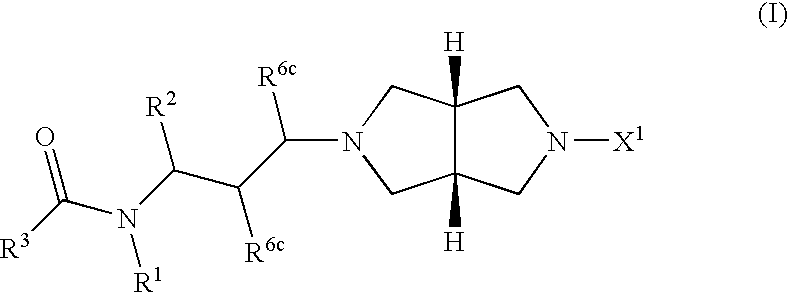Heterocylic antiviral compounds
a technology of heterocylic antiviral compounds and pyrrole derivatives, which is applied in the direction of biocide, drug composition, immunological disorders, etc., can solve the problems of limiting the utility of long-term therapy, complex dosing regime, and side effects that can be very sever
- Summary
- Abstract
- Description
- Claims
- Application Information
AI Technical Summary
Problems solved by technology
Method used
Image
Examples
example 1
[0133] Cyclopentanecarboxylic acid {(S)-3-[5-(2-carbamoylmethoxy-4,6-dimethyl-pyrimidine-5-carbonyl)-hexahydro-pyrrolo[3,4-c]pyrrol-2-yl]-1-phenyl-propyl}-amide (I-2) and (5-{5-[(S)-3-(Cyclopentanecarbonyl-amino)-3-phenyl-propyl]-hexahydro-pyrrolo[3,4-c]pyrrole-2-carbonyl}-4,6-dimethyl-pyrimidin-2-yloxy)-acetic Acid Benzyl Ester (I-3)
[0134] step 1—To a mixture of 2-acetyl-3-methoxy-but-2-enoic acid methyl ester (WO2005 / 007608) (34.4 g, 0.200 mol) and 2-methyl-2-thiopseudourea sulfate (33.4 g, 0.120 mol) in a mixture of acetone / MeOH (1.4 / 1, 240 mL) cooled in a ice-water bath (4), filtered and concentrated to give a brown oil that solidified on standing. This material was purified via SiO2 chromatography eluting with hexane / EtOAc to afford 32.1 g (76%) of 42a as white solid.
[0135] step 2—To a suspension of 42a (31.9 g, 0.150 mol) in a 1:1 mixture of water / MeOH (54 mL) was added a solution of NaOH (6.33 g, 0.158 mol) in water (20 mL). The mixture was stirred at 50° C. overnight, the...
example 2
Cyclopentanecarboxylic Acid [(S)-3-[5-(3,5-dimethyl-1-pyrimidin-5-yl-1H-pyrazole-4-carbonyl)-hexahydro-pyrrolo[3,4-c]pyrrol-2-yl]-1-(3-fluoro-phenyl)-propyl]-amide (II-5)
[0143]
step 1—N,N′-Dimethylethylenediamine (90 μL, 0.832 mmol) was added to a mixture of 3,5-dimethyl-1H-pyrazole-4-carboxylic acid ethyl ester (45, 1.4 g, 8.324 mmol), 5-bromopyrimidine (1.32 g, 8.303 mmol), CuI (0.16 g, 0.84 mmol) and K2CO3 (2.3 g, 16.64 mmol) in 1,4-dioxane (8 mL) that was maintained under an Ar atmosphere. The resulting mixture was stirred at 110° C. under Ar for 16 h. The reaction mixture was cooled to RT, diluted with DCM (50 mL) and filtered through a CELITE® and SiO2 pad. The filter cake was rinsed with EtOAc and the filtrate was evaporated in vacuo. The residue was purified via SiO2 chromatography eluting with hexane / EtOAc to afford the 0.150 g (7%) of 46a.
step 2—A solution of KOH (77 mg, 1.38 mmol) in water (0.5 mL, plus 0.25 mL to rinse) was added to a solution of 46a (170 mg, 0.69 mmo...
example 3
Cyclopentanecarboxylic Acid {(S)-3-[(5-(3,5-dimethyl-1-pyridazin-3-yl-1H-pyrazole-4-carbonyl)-hexahydro-pyrrolo[3,4-c]pyrrol-2-yl]-1-phenyl-propyl}-amide (II-1)
[0144]
step 1—Ethyl diacetoacetate (2 mL, 12.8 mmol) was added at RT to a mixture of 3-chloro-6-hydrazinopyridazine (1.5 g, 10.4 mmol) and HOAc (1 mL) in MeOH (30 mL). The resulting mixture was stirred at RT for 1 h. The resulting precipitate formed was filtered and rinsed with EtOH. The process was repeated twice as more product precipitated form the filtrate. The combined solids afforded 1.75 g (60%) of 50a.
step 2—A suspension of 50a (1.75 g, 6.25 mmol) and Pd / C (10%, 250 mg) in 5:1 MeOH / 1,4-dioxane (120 mL) was stirred under a H2 atmosphere (balloon pressure) at RT for 72 h. The catalyst was filtered, and the filter cake was rinsed with MeOH. The filtrate was evaporated and the residue was purified via SiO2 chromatography eluting with hexane / EtOAc to afford 0.340 g (22%) of 50b.
step 3—To a solution of 50b (0.34 g, 1.3...
PUM
| Property | Measurement | Unit |
|---|---|---|
| temperature | aaaaa | aaaaa |
| temperature | aaaaa | aaaaa |
| temperature | aaaaa | aaaaa |
Abstract
Description
Claims
Application Information
 Login to View More
Login to View More - R&D
- Intellectual Property
- Life Sciences
- Materials
- Tech Scout
- Unparalleled Data Quality
- Higher Quality Content
- 60% Fewer Hallucinations
Browse by: Latest US Patents, China's latest patents, Technical Efficacy Thesaurus, Application Domain, Technology Topic, Popular Technical Reports.
© 2025 PatSnap. All rights reserved.Legal|Privacy policy|Modern Slavery Act Transparency Statement|Sitemap|About US| Contact US: help@patsnap.com



